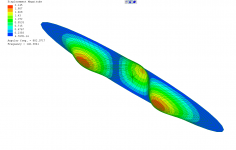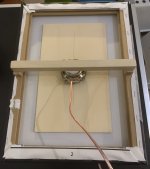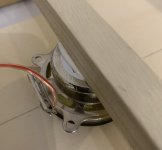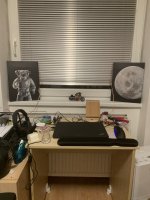Hello XRK,Thanks - I linked this to the first post. Very nice work. I see you are a latex fan - you must be a mathematician?
Happy if this kind of paper can help. Thank you
Despite appearances, I am not a latex fan but of (I hope) pragmatic tools. By the way, I know people using latex, starting by my son for his degree (for mine, it was hand writing!). Here more skill people than me used latex as an intermediate step in a chain of tools starting with markdown (plain text) to export pdf (pandoc, multiplateform, I recommend it). My personal touch was, other tools do it also, to export the documentation from the python script (see the github link in the document or on the left part of the post if you want to go further). The final document is clean with all the functionalities I expected without spending time on the format.
Christian
Hi Christian,Hello Burnt
You remark is completely legitimate. The question is where to put the cursor between full reflection to no reflection. Some adjustment of the edges might help. At least it is a good thing to be aware of those black hole. I was really surprised with video. The aluminum barre is simply no more ringing. It is also the shape of the end of the bracing barre in guitar top no? When a panel is thinned in the voice coil area, is it that also?
Christian
I agree there is a balance to be struck. Part of the theory I read in the early patents is the ideal of a panel as an infinite plane so there was no reflection from the edges ( contradicting the role of radiused corners reflecting back more efficiently but then the theory is still a work in progress) and ABH treatment to the edge is one way to accomplish that. It was discussed a while back but I don't think anyone has tried it yet. The Goebel DML panel attempts a different approach to edge absorption using a combination of angled slots and elastomeric filler in the slots.That might be easier to implement. The Goebel panel is reported as having excellent performance.http://www.goebel-highend.de/technology.html
Burnt
My Ikea canvas panels are waiting for the glue to set. The construction glue filled the gap nicely, I tried to align the exciters as good as possible. Just laid on the canvas and being held by hand, the sound was pretty good, so I am looking forward to some listening tomorrow🙂
Attachments
I could not resist. I just connected the panels and had a brief listen. Compared to the large ones, these are really tiny, like 1/4 of the area, but due to the tighter canvas, the bass is better - tighter🙂 And also lower. The temporary placement is far from perfect, they need to be away from the wall for balanced sound as Steve pointed out. The imaging is simply awesome - and that is with a cheap class D Bluetooth amp powered by an old laptop PSU. They are definitely keepers, I will disassemble the large ones and reuse the exciters somewhere else.
I need to build some sort of "gallows" stands fixed to the table and hang them there. Most probably with a hinge.
The next step for me would be some sort of high output panel with 4 exciters and a matching bass unit for higher level listening.
I need to build some sort of "gallows" stands fixed to the table and hang them there. Most probably with a hinge.
The next step for me would be some sort of high output panel with 4 exciters and a matching bass unit for higher level listening.
Attachments
No worries. Funny you should mention ellipses, because when I read about ABH, I was thinking of a design with two vertical ellipses of different sizes overlapping, with foci coincident, and an ABH at the other foci of each ellipse.Hello Paul,
Sorry, I was not clear... the connections in my neurons went to fast or more probably chaotic!
So about the guitar, I have only the contours. Reading your post, I thought I should have also taken notes of the hole characteristics (position, diameter) as it plays also a role in how the waves travel in the guitar top.
Then my brain jumps to the ABH and the paper linked : an ellipse with an ABH, thinking it might be something in your research area.
So, no more material from my side at the moment.
Christian
I believe that damping is important, but low frequencies need proportionally more damping. If damping is such that all frequencies decay (say to 1/e) in 10 cycles (and something like this seems to be typical of vibrating systems), then impulse response will be dominated by low frequencies. In my experience with XPS, the high frequencies are so well damped that they don't even reach the edge of the panel, but tap the panel and you can hear the LF for many seconds. ABH or some less fancy damping at or near edges is required to damp LF.
Paul,So anyhow, I am interested initially to use fem to do some statistical tests on the eigenfrequencies for different shapes.
No statistics here, but I thought I'd look at an ellipse! Here's what I get with LISA for a elliptical 5-layer plywood panel, 0.3 m x 2.0 mm (a bit tall, but only 0.47m2!) Eigenfrequencies are in Hz, with the odd,odd modes highlighted yellow.
From my experiments with rectangular panels, I like to get the aspect ratio high enough that the 1,3 mode is only about 30% higher in frequency than the 1,1 mode. This usually is enough to eliminate the big drop in SPL between the two. According to the LISA model, I needed a significantly higher aspect ratio (nearly 7:1) than for a rectangular panel (about 3.5:1). But another interesting thing is that the displacement amplitudes for the antinodes closest to the ends of the ellipse are much larger than that of the more central antinodes. See the image below of the 1,3 mode. I wonder if that makes the odd,odd modes even more dominant.
Eric

The ellipse becomes very pointy if you make a high aspect ratio. Maybe look instead at the stadium?Paul,
No statistics here, but I thought I'd look at an ellipse! Here's what I get with LISA for a elliptical 5-layer plywood panel, 0.3 m x 2.0 mm (a bit tall, but only 0.47m2!) Eigenfrequencies are in Hz, with the odd,odd modes highlighted yellow.
From my experiments with rectangular panels, I like to get the aspect ratio high enough that the 1,3 mode is only about 30% higher in frequency than the 1,1 mode. This usually is enough to eliminate the big drop in SPL between the two. According to the LISA model, I needed a significantly higher aspect ratio (nearly 7:1) than for a rectangular panel (about 3.5:1). But another interesting thing is that the displacement amplitudes for the antinodes closest to the ends of the ellipse are much larger than that of the more central antinodes. See the image below of the 1,3 mode. I wonder if that makes the odd,odd modes even more dominant.
Eric
View attachment 1107327
View attachment 1107329
It would be nice to have a way of identifying odd. odd modes, or rather the 'productive' mode shapes in arbitrary panel shapes, without having to go to the trouble of completely modelling results in the far field.
A first cut could be to just find the average displacement, or weighted average displacement across the panel. But no doubt there are much better algorithms that have similar results to the overall modal radiation efficiency to far field, without needing to model everything. Something that accounts for the distance between out-of-phase displacements at the modal frequency, which will cancel more completely if a smaller fraction of a wavelength apart.
Last edited:
Cantilever panels? Part 1
Here are some stats on the separation of consecutive modal frequencies in a simply supported panel (2:1 aspect), and a cantilever panel clamped on one end.
All stats pertain to the set of modal frequencies less than 1000 Hz, except for the mode count less than 100 Hz.
| Mode Count f < 1000 Hz | Mode count f < 100 Hz | mean separation f < 1000 Hz | separation std dev f < 1000 | min separation f < 1000 Hz | max separation f < 1000 Hz | |
| Simple supp | 43 | 2 | 23 | 19 | 0.04 | 63 |
| Cantilever | 60 | 8 | 17 | 13 | 0.05 | 56 |
Note that:
- There are more modes less than 1000 Hz and more less than 100 Hz for cantilever
- The standard deviation of modal separation is significantly less for cantilever
- The maximum separation is less for cantilever
Note that both have small minimum separation, and there do seem to be a lot of values near zero in each case. This seems to point at the existence of modal degeneracy, which I believe will be improved with asymmetry and/or shapes which are chaotic billiards, and so reduce the standard deviation for each case.
Cantilever Panels? Part 2
I'm imagining a panel design using cantilevers on each end of a high aspect ratio panel (> 3:1)
Imagine the exciter surrounded by four pins - two above, two below on the edges of the panel, supporting the panel but leaving the ends free as cantilevers, acting somewhat independently.
The vertical position of the exciter & pins would be determined by the best modal overlap from the two cantilevers.
Having two independent oscillators with adjustable length gives a good latitude for finding a sweet design.
I was originally thinking of four-lobed or higher lobed starfish-like shapes, but maybe two is enough, given the higher modal density of cantilevers as mentioned in the last post.
Additionally, if you surround the panel with a baffle, the possibility arises to be able to drive the edges with a linear voice coil and strip magnets on the edge, at least for LF. I don't know how much noise to expect though from the edges moving very close to the baffle.
I wonder too whether the damping characteristics of cantilever are favourable, with the ends having higher velocity and more viscous damping from the air.
Last edited:
Oh, forgot to mention the fact that cantilever simply goes lower, because fundamental mode shape is quarter-wave rather than half-wave..
This opens to a new field of solutions... The DNA (or in other words degree of freedom = number of variables) of the DML is large! Which family of solutions will have successors?Oh, forgot to mention the fact that cantilever simply goes lower, because fundamental mode shape is quarter-wave rather than half-wave..
About the cantilever on one side, solutions might be provided to keep the membrane flat (problem of warping often encountered) and about the transmission of vibrations to the environment (the floor?). Design with a complete or partial suspension avoid this by nature.
But it remains a way to push.
Christian When experimenting my son found found close coupling of the Tall Blondes to the floor improved the bass performance. The basses were weighted from then on. For simple objects they have a complex behaviour.This opens to a new field of solutions... The DNA (or in other words degree of freedom = number of variables) of the DML is large! Which family of solutions will have successors?
About the cantilever on one side, solutions might be provided to keep the membrane flat (problem of warping often encountered) and about the transmission of vibrations to the environment (the floor?). Design with a complete or partial suspension avoid this by nature.
But it remains a way to push.
Burnt
Paul,Cantilever Panels? Part 2
I'm imagining a panel design using cantilevers on each end of a high aspect ratio panel (> 3:1)
Imagine the exciter surrounded by four pins - two above, two below on the edges of the panel, supporting the panel but leaving the ends free as cantilevers, acting somewhat independently.
I'm having a hard time visualizing it. Can you share a sketch?
Eric
Goebel panels are based on bending wave principles.Hi Christian,
I agree there is a balance to be struck. Part of the theory I read in the early patents is the ideal of a panel as an infinite plane so there was no reflection from the edges ( contradicting the role of radiused corners reflecting back more efficiently but then the theory is still a work in progress) and ABH treatment to the edge is one way to accomplish that. It was discussed a while back but I don't think anyone has tried it yet. The Goebel DML panel attempts a different approach to edge absorption using a combination of angled slots and elastomeric filler in the slots.That might be easier to implement. The Goebel panel is reported as having excellent performance.http://www.goebel-highend.de/technology.html
Burnt
He says he does not like dml.
Is he right?
Supposedly a goebel room was at the last audio show I went to, but somehow I missed it.
The maps were a little confusing and it was a rush to get around all the rooms in one day.
Having a panel thick enough to try out ABH with Edge damping is going to rule out quite a few materials I think?
Steve.
EricNote that both have small minimum separation, and there do seem to be a lot of values near zero in each case. This seems to point at the existence of modal degeneracy, which I believe will be improved with asymmetry and/or shapes which are chaotic billiards, and so reduce the standard deviation for each case.
At first I thought you meant eigenfrequencies near zero, and were misinterpreting rigid body rotations. But what you meant was "values of separation" near zero, right?
I don't think low values of separation is necessarily a problem, unless both are "productive" frequencies. The situation I try to avoid is that the 1,3 and 3,1 are very close, like for a nearly square isotropic panel, or a nearly isotropic square panel. At certain aspect ratios the 1,3 and 5,1 can land close to each other as well, which I would also generally try to avoid.
For me, the relationships of the first 4 or 5 eigenvalues are far more important than the rest, at least assuming that the intention is to use the panel down to that frequency range.
Eric
Hi EricPaul,
I'm having a hard time visualizing it. Can you share a sketch?
Eric
Have to go to bed now, but here's a quick sketch - Paul
Steve,Goebel panels are based on bending wave principles.
He says he does not like dml.
Is he right?
Supposedly a goebel room was at the last audio show I went to, but somehow I missed it.
The maps were a little confusing and it was a rush to get around all the rooms in one day.
Having a panel thick enough to try out ABH with Edge damping is going to rule out quite a few materials I think?
Steve.
Too bad you missed the Goebel room.
I always wonder if the Goebel panel isn't more modal than Goebel would like to admit.
I agree, trying out the ABH with most panels, like plywood or multilayer composites would be pretty difficult. But I was thinking PS foam, being relatively thick and homogenous would be a good candidate.
Eric
Yes I meant difference in frequency between adjacent modes. Shapes with high symmetry can have modes of the same frequency - ie they are “degenerate”. Introducing asymmetry (and, I’m hoping , the chaotic billiard shape thing) can separate these leading to a smoother spectrum. Yes they both have to be productive for that to help.Eric
At first I thought you meant eigenfrequencies near zero, and were misinterpreting rigid body rotations. But what you meant was "values of separation" near zero, right?
I don't think low values of separation is necessarily a problem, unless both are "productive" frequencies. The situation I try to avoid is that the 1,3 and 3,1 are very close, like for a nearly square isotropic panel, or a nearly isotropic square panel. At certain aspect ratios the 1,3 and 5,1 can land close to each other as well, which I would also generally try to avoid.
For me, the relationships of the first 4 or 5 eigenvalues are far more important than the rest, at least assuming that the intention is to use the panel down to that frequency range.
Eric
Certainly the lowest frequencies have the most need of support. The gaps between adjacent eigenfrequencies don’t seem to increase in log fashion - they seem to be relatively constant. So of course, proportional to frequency the bottom end gets fewer peaks. That’s why I’m considering additional lobes etc, as each can have an approximately independent set of LF peaks which add support.
But there is a good deal of unevenness in the mid range also, so additional peaks always helps.
yes it wouldn’t worked for layered material I think. I doubt it would work well with foam, as it’s not strong enough to use in thin sections. Acrylic or polycarbonate should work I guess.Having a panel thick enough to try out ABH with Edge damping is going to rule out quite a few materials I think?
Steve.
I think Eric is right on this Steve, it looks like a DML to me and the bending wave model sounds like a variation on transverse waves.Goebel panels are based on bending wave principles.
He says he does not like dml.
Is he right?
Supposedly a goebel room was at the last audio show I went to, but somehow I missed it.
The maps were a little confusing and it was a rush to get around all the rooms in one day.
Having a panel thick enough to try out ABH with Edge damping is going to rule out quite a few materials I think?
Steve.
Burnt
- Home
- Loudspeakers
- Full Range
- A Study of DMLs as a Full Range Speaker


